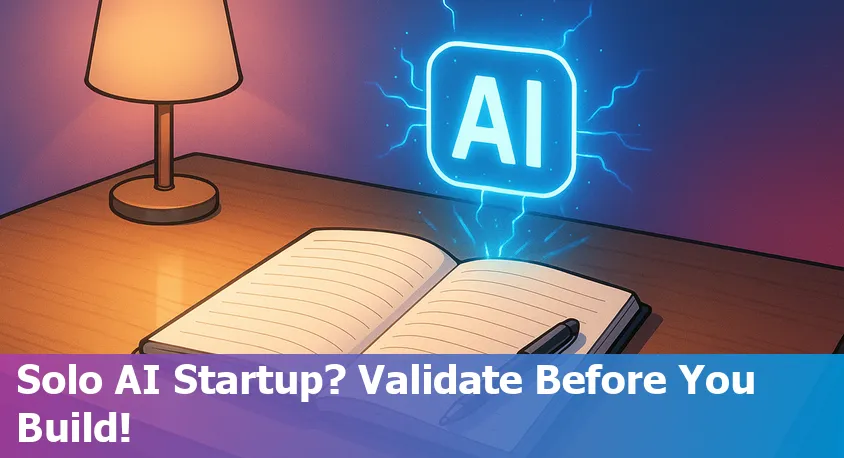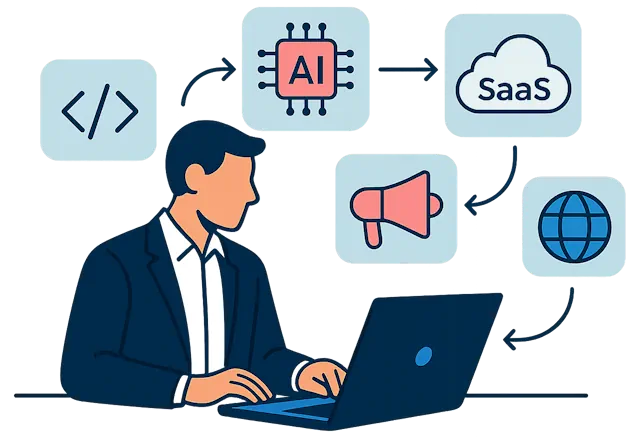Validating Your Solo AI Startup Idea Before Development
Last Updated: June 1st 2025

Too Long; Didn't Read:
Validating your solo AI startup idea before development is crucial, as over 90% of startups fail within five years - often due to poor validation. Combine AI tools with real customer interviews, rapid MVP testing, and proven frameworks like Lean Startup. Target at least 10–20 interviews and a 10%+ conversion pre-launch for measurable traction.
Validating your solo AI startup idea before development is not just a smart step - it's fundamental to survival and growth. Research shows that 42% of startups fail due to a lack of market need, while more than 90% don't make it past year five, often because the concept hasn't been adequately tested against real-world problems or customer pain points.
As AI-driven validation tools rapidly evolve, founders can now leverage machine learning and natural language processing to analyze market demand, refine value propositions, and uncover unique opportunities at a fraction of traditional costs and time requirements (learn how AI is enhancing validation accuracy and speed).
Yet, successful validation is more than data: it's about combining rapid AI-powered insights with human judgment, direct user interviews, and iterative MVP testing to avoid wasted resources and costly pivots - especially critical when building with limited bandwidth.
As Peter Thiel observes,
"Competition is for losers. True success comes from creating something unique."
Grounding your solo AI startup in thorough validation protects your investment, sharpens your differentiation, and sets the foundation for measurable traction.
For a detailed breakdown of today's best validation frameworks and step-by-step AI validation methods, see this comprehensive guide on how to validate startup ideas with AI.
Table of Contents
- Common Pitfalls Solo AI Founders Face During Validation
- Step-By-Step Guide for Validating Your Solo AI Startup Idea
- Must-Know Validation Frameworks and Tools for Solo AI Startups
- How to Measure and Interpret Traction Before Building
- Solo Founder Validation Checklist and Timeline
- Inspiring Real-World Examples of Solo AI Startup Validation
- Final Thoughts: Blending AI, Human Feedback, and Fast Action
- Frequently Asked Questions
Discover how bootstrapping an AI business with no money is possible by leveraging free tools and global resources.
Common Pitfalls Solo AI Founders Face During Validation
(Up)Solo AI founders often encounter unique validation pitfalls that can derail their progress before launch. A significant challenge arises from confirmation bias, where solo founders - especially when working extensively with AI tools - gravitate toward feedback that amplifies their belief in their idea rather than seeking impartial critique.
As one founder observed,
“GPT is an ego's best friend. Every question I asked to explore my plan was met with a congratulatory tone,”
highlighting how AI validation can be seductive and misleading without critical outside input (common pitfalls of an AI-first startup).
Additionally, AI-generated content can present issues such as factual inaccuracies, fabricated research, or ethical risks that undermine startup credibility and lead to wasted resources or actual legal harm (trust issues with AI and the risks of trusting it).
Solo founders also face decision paralysis - without a co-founder's feedback loop, founders may either stall or make poorly considered choices; in fact, it's estimated that
“70% of startup failures stem not from bad decisions but from decisions made too late”(critical decision-making mistakes solo founders make).
Combined with a tendency to overengineer products, ignore real customer feedback, or trust overpromised AI capabilities, these pitfalls underscore the importance of systematic validation, skepticism of AI hype, and a commitment to seeking human feedback throughout the startup journey.
Step-By-Step Guide for Validating Your Solo AI Startup Idea
(Up)Validating your solo AI startup idea involves a series of focused, actionable steps that combine hands-on research and modern tools. Start by clearly defining your validation goals - are you aiming to confirm market demand, identify core user problems, or benchmark competitors? Next, outline your target audience using buyer personas created from demographic and behavioral data.
Leverage primary research with direct user outreach, such as surveys and interviews; engaging directly with your prospective customers - joining relevant events or active online groups - can provide invaluable feedback, as solo founders consistently recommend personal interaction for deep insight:
“Join a social event where your target audience goes and ask people. The first one is the hardest to get. With a few you will nail your approach.”
AI can amplify your research by streamlining interview documentation, sentiment analysis, and even generating tailored interview questions, ensuring a blend of qualitative and quantitative insights without losing the crucial human touch.
As you move forward, conduct a competitive analysis early using both AI-driven and traditional tools to understand existing solutions, their strengths and weaknesses, and to uncover unique opportunities for differentiation.
For a practical framework and tools, this guide on conducting startup market research illustrates a step-by-step process - including case studies on rapid, affordable market validation.
Meanwhile, using AI for ongoing competitor monitoring and trend analysis, as explained in this comprehensive overview of AI for competitor research, helps you stay agile and well-informed.
Finally, AI-powered platforms now enable even solo founders to organize, analyze, and act on market and customer data efficiently - the 7 Ways to Use AI to Improve User Interviews guide details practical methods for integrating AI in your user validation workflow, optimizing both depth and speed of your insights.
Must-Know Validation Frameworks and Tools for Solo AI Startups
(Up)For solo AI founders, a solid understanding of validation frameworks and modern tools is key to minimizing risk and increasing confidence before building your product.
Three of the most effective frameworks are Lean Startup (which emphasizes rapid experimentation, minimum viable products, and iterative learning), Effectuation (focusing on leveraging resources at hand and controlling what you can with limited means), and Disciplined Entrepreneurship (a step-by-step system for systematically building and scaling new ventures).
The table below summarizes their core principles and best-fit scenarios:
| Framework | Core Question | Strengths | Ideal For |
|---|---|---|---|
| Lean Startup | Will people buy this? | Rapid cycles, evidence-based iteration | Tech startups, high uncertainty |
| Effectuation | What can we do with what we have? | Resourcefulness, adaptability | Solo founders, limited resources |
| Disciplined Entrepreneurship | How do we systematically build this? | Comprehensive steps, structure | First-time founders, complex products |
Tools such as ValidatorAI and FeedbackbyAI's free startup idea validator make it seamless to generate, score, and pressure-test your AI startup idea using market data, user sentiment, and actionable reports.
As emphasized by practitioners,
“Frameworks provide essential structure for problem-solving and decision-making in product management… They offer a systematic approach to addressing complex challenges and ensure alignment with strategic goals.”
Explore how these frameworks and validation platforms can help you refine your concept, understand your market, and set the stage for building a solution that people actually want by consulting resources like the Comprehensive Guide to Entrepreneurship Frameworks.
How to Measure and Interpret Traction Before Building
(Up)Before building your solo AI startup, it's vital to measure and interpret traction by tracking key pre-launch metrics that reveal true market demand, product appeal, and financial viability.
Successful founders go beyond vanity numbers, focusing on four core metric categories: customer engagement, product engagement, financial metrics, and a critical path metric known as your “North Star” (essential pre-launch metrics for startup success).
That means quantifying not just site visits but active interest - like email sign-ups, waitlist growth, or beta usage - and prioritizing feedback that leads to actionable improvements.
Incorporate AI-powered tools to track emerging market trends, user sentiment, and competitor activity, giving you predictive insight while optimizing for customer fit (how AI predicts product success).
As a solo founder, leverage practical strategies such as A/B testing landing pages or collecting sign-up intent to objectively test different value propositions before launch.
The table below summarizes core pre-launch metrics to monitor:
| Metric Category | Examples |
|---|---|
| Customer Engagement | Interest sign-ups, early adopter profiles, awareness rates |
| Product Engagement | MVP adoption, user retention, satisfaction (NPS) |
| Financial Metrics | Unit economics, cost per acquisition, cash runway |
| Critical Path Metric | First 100 users, waitlist goals, prototype feedback |
“You can't manage what you can't measure.” – Peter Drucker
Staying data-driven and iterative not only de-risks your build but also ensures you're solving a real problem - a lesson emphasized by leading validation frameworks and founders' shared experiences (best startup idea validation practices).
Solo Founder Validation Checklist and Timeline
(Up)Solo AI founders can dramatically increase their chances of product-market fit by following a focused validation checklist with clear timelines. Begin by ensuring there's a real, significant problem - conduct at least 10-20 customer discovery interviews and document the pain points that matter most.
Next, analyze your competition and fill out a Lean Canvas to capture your business model's essentials. Rapidly build a minimum viable product (MVP) with just 2-3 core features using no-code or AI tools, then launch a landing page or pre-sales campaign to gauge interest and willingness to pay - aim for a 10%+ conversion rate and 20% of engaged users making a pre-order.
Track critical metrics like signups, meaningful survey responses, and real commitments; continuously gather feedback through surveys and early user communities.
A recommended validation timeline is 24 hours for initial impossibility tests, 7-30 days for landing pages and interviews, and 1-3 months for MVP iterations, but high-level MVP launches can be achieved in less than a day using rapid methods.
| Step | Goal | Recommended Timeline |
|---|---|---|
| Customer Interviews | 10–20+ completed | 1–7 days |
| Landing Page/Pre-sales | 10% conversion, 20% pre-orders | 7–30 days |
| MVP Launch | 2–3 core features | 1–3 months (or less with AI/no-code) |
As Marshall Hargrave puts it,
“Validation isn't about proving your idea will work. It's about trying to prove it won't work – and failing to do so.”
For an actionable, stepwise process and field-tested strategies, explore detailed frameworks from How to validate your startup idea in 24 hours, a comprehensive checklist at Tech Startup: Solo Founder Validation & Pre-Orders, and the 30-day market validation plan from StartupStash.
Inspiring Real-World Examples of Solo AI Startup Validation
(Up)Solo founders in the AI space can take inspiration from recent real-world startup validation journeys, revealing how resourcefulness and structured user feedback can derisk big ideas.
Startups like Vanta and Cocoon validated their markets by first conducting deep customer interviews and then testing zero-code MVPs or simple design prototypes directly with target users - securing first customers and inbound interest before a single line of code was written.
Snackpass, for instance, won over nearly 90% of Yale's student body within six months by starting small - convincing five local restaurants and running hands-on experiments - illustrating that impact stems from solving urgent, clearly defined problems.
As summarized in this comprehensive breakdown of founder validation milestones, the most successful solo AI founders turn assumptions into specific hypotheses, run focused interviews instead of broad surveys, and use low-cost MVPs to test demand quickly.
Results-driven approaches, such as landing pages with signups and iterative “concierge” solutions, help confirm real intent before further investment; founders like those at Pinwheel and LaunchDarkly tracked waitlist signups, pre-orders, and, eventually, revenue traction as evidence of product-market fit.
A quick comparison of proven validation strategies is shown below:
| Startup | Validation Method | Key Traction Signal |
|---|---|---|
| Vanta | Zero-code MVP, founder interviews | Unsolicited inbound requests, Y Combinator admission |
| Cocoon | Design prototypes (Figma), focused user feedback | First customers signed from mockups |
| Pinwheel | PR article, tracked inbound leads | 133 leads post-launch, major clients onboarded |
“Validation involves progressing from market analysis to user engagement, prototype testing, and iterative feedback integration.”
To learn more, review case studies in the article How to validate your startup idea and explore a concise guide with practical steps at Validating Your Startup Idea Before Investing in Full Development.
Final Thoughts: Blending AI, Human Feedback, and Fast Action
(Up)Validating your solo AI startup idea before development means blending the rapid power of AI with strategic human feedback and swift, iterative action. Leveraging AI-driven platforms allows solo founders to generate market analyses, prototype designs, and synthetic user personas in a fraction of the time - cutting weeks of research to mere hours and enabling more informed decisions about product-market fit, pricing, and demand (the role of AI for idea validation).
Yet, as AI streamlines data processing and boosts productivity by as much as $4.4 trillion annually across industries, experts caution that over-reliance on algorithms risks amplifying bias and reducing the nuanced understanding that comes from direct customer engagement.
As noted in an industry field guide,
“The most important AI investment is a simple data viewer… Empowers domain experts to write prompts and empowers learning from both failures and successes.”
This hybrid approach - using AI for scale and automation, then validating with real-world customer interviews and feedback - enables solo founders to move quickly while staying responsive and human-centered.
For a practical roadmap and tool comparison that demonstrates how AI accelerates MVP validation yet underscores the irreplaceable value of qualitative insights and ethical oversight, review this thorough guide on rapidly improving AI products.
Ultimately, the most resilient solo AI startups are those that balance AI's scale with continuous user feedback, conscious bias mitigation, and agile adaptation - principles echoed in both innovation research and real-world product launches (why customer feedback still matters to top product teams).
Frequently Asked Questions
(Up)Why is validation critical before developing a solo AI startup?
Validation is critical because over 90% of startups fail within five years, often due to a lack of real-world problem fit or customer need. Validating your AI startup idea prior to development helps confirm market demand, ensures you're addressing real customer pain points, and prevents wasted resources on ideas that won't gain traction.
What are the common pitfalls solo AI founders face during validation?
Solo AI founders often face confirmation bias (seeking only supportive feedback), overreliance on potentially misleading AI-generated insights, decision paralysis due to lack of team feedback, and misjudging market signals. These pitfalls can lead to ignoring real customer input, making late or poor decisions, and overengineering solutions.
What are the key steps to validate a solo AI startup idea?
Key steps include: 1) clearly defining your validation goals; 2) outlining your target audience using buyer personas; 3) conducting direct user outreach through surveys and interviews; 4) leveraging AI tools for market research and sentiment analysis; 5) performing competitive analysis; and 6) building and testing a minimum viable product (MVP) while tracking pre-launch metrics such as sign-ups and user engagement.
Which validation frameworks and tools are recommended for solo AI startups?
Three leading frameworks are Lean Startup (focused on rapid iteration and evidence-based learning), Effectuation (emphasizing resourcefulness for founders with limited means), and Disciplined Entrepreneurship (providing a step-by-step process). Solo founders should also use modern AI-driven validation platforms for idea scoring, competitive analysis, and user research.
How can solo founders measure traction before building their product?
Solo founders should measure traction using actionable, pre-launch metrics such as interest sign-ups, waitlist size, user survey responses, initial MVP usage, unit economics, and a core 'North Star' metric (e.g., first 100 users). Using A/B tests, landing pages, and AI-powered analytics helps founders gauge real demand and iteratively refine their product-market fit.
Stay ahead of the curve by learning about future trends in AI infrastructure and how they'll impact solo tech entrepreneurs.
Avoid setbacks by recognizing common pitfalls in machine learning integration encountered by many first-time founders.
Master the intent-to-deployment workflow for rapid solo development using cutting-edge AI tools.
Learn how text summarization tools for efficiency can save precious time for solo AI entrepreneurs.
Discover how AI-driven retention strategies can give solo founders a competitive edge in today's fast-changing tech landscape.
Explore the necessity of ongoing audits and monitoring to identify threats and demonstrate compliance in a dynamic tech landscape.
Customize your development environment using open-source AI integration for coding and enhance your creative control.
Learn how the long-term savings of self-hosting make it a game-changer for solo AI entrepreneurs.
Ludo Fourrage
Founder and CEO
Ludovic (Ludo) Fourrage is an education industry veteran, named in 2017 as a Learning Technology Leader by Training Magazine. Before founding Nucamp, Ludo spent 18 years at Microsoft where he led innovation in the learning space. As the Senior Director of Digital Learning at this same company, Ludo led the development of the first of its kind 'YouTube for the Enterprise'. More recently, he delivered one of the most successful Corporate MOOC programs in partnership with top business schools and consulting organizations, i.e. INSEAD, Wharton, London Business School, and Accenture, to name a few. With the belief that the right education for everyone is an achievable goal, Ludo leads the nucamp team in the quest to make quality education accessible


